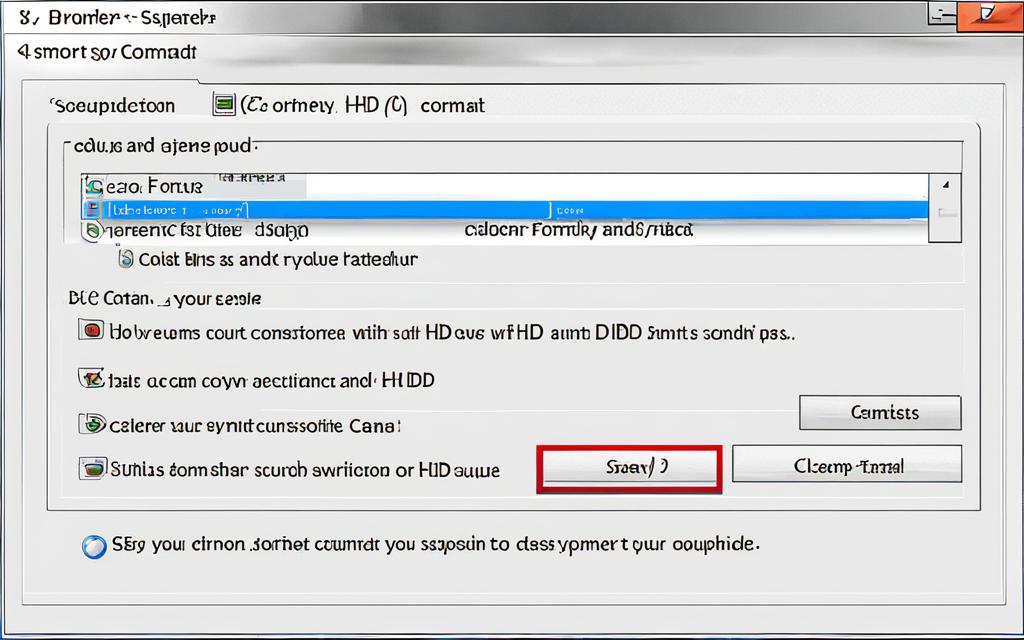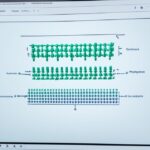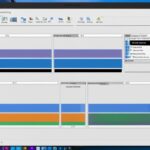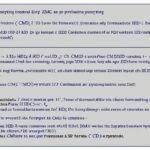Table of Contents
Formatting a hard disk drive (HDD) effectively organises your storage. By using the command prompt, you can fully erase all data. This makes it like a brand new hard drive. Our CMD formatting guide offers step-by-step instructions. It’s for formatting both internal and external HDDs. DiskPart is available on various Microsoft operating systems, including Windows 2000, XP, Vista, 7, 8, and 101. This guide will walk you through the commands required for formatting.
The process includes selecting drives, cleaning them, creating partitions, and setting file systems. These skills are crucial for top-notch hard drive management1. By following this tutorial, you’ll learn how to format an HDD via command prompt. This will improve your storage management.
Key Takeaways
- Formatting an HDD is vital for managing digital storage effectively.
- Command prompt offers a structured way to erase data and prepare hard drives.
- DiskPart is a widely available utility on multiple Windows operating systems.
- Pre-formatting steps are crucial, including ensuring data is backed up to prevent loss.
- Understanding different file systems is essential when formatting.
Understanding HDD Formatting
When we talk about HDD formatting, we need to know what this process means.
It’s about getting a hard drive ready for use by setting up a file system that works with the computer’s operating system. Whether you’re dealing with a brand-new drive or wiping an old one to start over, this step is crucial. Using Command Prompt to format hard drives is shown to be efficient and accurate, with its importance and precision highlighted on June 21, 20242.
What is HDD Formatting?
‘HDD formatting’ means wiping off existing data and setting up a new file system on the drive. This is done so the operating system can manage and access digital information properly. Hard drives are adaptable, able to store both personal files and system data, which shows how important they are for computing work2.
Reasons for Formatting Your HDD
People format HDDs for various reasons. It helps clear space, fix disk issues, and eliminate stubborn viruses. It also makes the drive work better with different devices and operating systems. Formatting is crucial for the drive’s health and good performance. It’s a necessary step for both internal and external drives.
Differentiating Between Internal and External Drives
The distinction between internal and external drives is key to storage planning. Internal drives sit inside the computer, offering speed and reliability for the best performance. On the other hand, external drives are portable. They connect through USB or other interfaces, making data swaps easy. They are great for backups or extra space. This difference shows why users might format drives based on their specific needs.
Understanding HDD formatting is vital for anyone wanting to handle their data well. This includes dealing with both internal and external drives effectively and efficiently3.
Preparing to Format Your HDD
Before you start formatting your HDD, it’s important to be ready. This means you should back up your data and know your HDD’s details. These actions help avoid data loss and make formatting smoother.
Importance of Backing Up Your Data
Backing up data is crucial before formatting. It stops you from losing data forever. You can save your important files on an external drive or online. Make sure to check your backups to ensure all important data is safe. This is key when using tools like DiskPart or using EaseUS Partition Master for free formatting options4.
Gathering Necessary Information About Your HDD
Start by finding out important details about your HDD. Know the storage size and file system. This helps choose the right formatting options. It’s smart to identify your disk number via CMD to avoid formatting the wrong drive4. Learn about different file systems like NTFS, FAT32, and exFAT to pick the right one4.
| File System | Best Use Case | Maximum File Size |
|---|---|---|
| NTFS | General use on Windows | 16 TB |
| FAT32 | Removable storage | 4 GB |
| exFAT | Files larger than 4 GB | Theoretically unlimited |
By backing up data and knowing about your HDD, you’re setting up for a smooth formatting process.
“Data is worth more than money. Always protect it.”
How to Format an HDD in CMD
Formatting an HDD with the Command Prompt might seem tough. But, the Diskpart command offers a lot of power for this task. It makes the whole process efficient but detailed. Here, we’ll look at how to do it step by step and what to keep in mind.
Step-by-Step Guide for Formatting
First, open Command Prompt as an admin. Type diskpart to use the Diskpart utility. Then, enter list disk to see all disks and pick the right one. You do this by typing select disk [number], with [number] being the disk’s ID. It’s very important to choose the right disk to avoid losing data.
After picking the disk, use clean to get rid of data and partitions. Next, create a new one with create partition primary. To format this partition, use format fs=ntfs for NTFS file systems. You could also pick FAT32 or exFAT depending on what you need. Each command must be exact, or you might have problems.
Using the Diskpart Command Effectively
The Diskpart command is crucial for disk management via Command Prompt. Make sure to enter the commands correctly to avoid mistakes. Mistakes could lead to formatting the wrong disk, causing data to be lost forever. Extra care is needed when using command line operations, especially for beginners. Learning CMD for HDD formatting gives you more control and flexibility with your storage.
Many Windows users, especially with Windows 11, find hard drive formatting hard. Tools like Diskpart offer solid solutions. Resources like this Diskpart command guide show different methods for various skill levels. Diskpart provides many options, improving the experience of managing HDDs in Windows 115.
If CMD is new to you, using simple commands can reduce confusion when formatting HDDs6. Following these format HDD CMD steps helps manage storage well. It also keeps data safe and secure during the process7.
Choosing the Right File System
Choosing the right file system for your hard drive matters a lot. It influences how well your drive performs and interacts with devices. The ongoing discussion between FAT32 and NTFS focuses on which is the best. Both options have their pros and cons. It’s important to know these to make a smart choice.
Comparing FAT32 and NTFS
FAT32 is well-liked because it works with many devices, making it ideal for USBs and old computers. But, it can’t handle files over 4GB or partitions over 32GB. This is tricky for those with bigger files8. NTFS, on the other hand, is better for modern Windows systems. It can manage bigger files and partitions and offers extra benefits like file permissions and journaling9. If you want better performance and security, NTFS is the way to go, especially for new apps.
When to Use exFAT File System
exFAT is great for moving files between different systems without FAT32’s downsides. It’s useful for flash drives and SD cards with files over 4GB. exFAT can handle large files and doesn’t have a partition size limit. This makes it versatile for both Windows and macOS. However, remember that you can’t format internal drives to exFAT with Disk Management8.
Conclusion
Learning how to format a hard drive using Command Prompt is a key skill. It lets you organise your storage well. Knowing how to do everything from the start to picking the right file system is crucial. It makes managing your data easier and improves how you use your computer.
Following the best practices for formatting a hard drive is very important. Make sure you back up your data before starting. The Command Prompt has options for quick and full formats to meet various needs. For those who prefer simpler tools, AOMEI Partition Assistant or EaseUS Partition Master are great choices. They are especially good for formatting external drives and fixing common Windows issues1011.
By mastering these techniques, you can make the most out of your hard drives. This leads to better organisation and performance of your computer. These final thoughts highlight the value of learning how to format hard drives. It’s a step towards better storage management and a smoother experience with technology.
FAQ
What does it mean to format an HDD?
Formatting an HDD means getting it ready by deleting all data and setting up a new file system. This lets your computer read and write data on the drive.
Why should I back up my data before formatting?
It’s key to back up your data since formatting wipes all files from the drive. Always save your important files elsewhere, like on an external drive or cloud, before formatting.
How can I determine the disk number of my HDD using CMD?
To find your disk number, open CMD with admin rights. Then, type ‘diskpart’ and ‘list disk’. This shows all drives and their numbers.
What are the key differences between FAT32 and NTFS?
FAT32 is widely compatible but limits file and partition sizes. NTFS, on the other hand, can handle larger files, has features like file permissions, and offers more security. It’s better for modern computers.
When is it appropriate to use the exFAT file system?
Use exFAT for USB drives and SD cards. It supports large files without FAT32’s limits and works well between Windows and macOS.
What should I do if I accidentally select the wrong disk during formatting?
If the wrong disk is formatted, try data recovery software or professional help. Success varies based on new data written since formatting.
Can I format both internal and external drives using the same method?
Yes, the formatting steps through CMD work for both internal and external drives. Just be sure to choose the correct disk to avoid losing data.
Is it possible to format a drive without losing data?
‘Quick format’ creates a new file system but keeps some file info. Still, back up your data first to avoid total loss.
What happens if I don’t back up my data before formatting?
Not backing up means all your files will be gone forever. Formatting is final, so backing up is crucial.
How do I access the CMD on my Windows computer?
Find ‘Command Prompt’ in the Start menu. Right-click it and choose ‘Run as administrator’ for disk commands.
Source Links
- https://recoverit.wondershare.com/format-hard-drive/format-hard-drive-diskpart-cmd.html – How to Format Your Hard Drive Using DiskPart and Command Prompt?
- https://www.geeksforgeeks.org/how-to-format-a-hard-drive-using-cmd/ – How to Format a Hard Drive Using the Command Prompt?
- https://recoverit.wondershare.com/format-harddrive/format-disk-cmd.html – How To Format Hard Drive Using CMD
- https://www.easeus.com/partition-master/format-hard-drive-using-command-prompt.html – DiskPart Format: How to Format Hard Drive Using DiskPart [Free]
- https://www.easeus.com/partition-master/format-external-hard-drive-on-windows.html – How Do I Format Hard Drive on Windows 11? 2024 Complete Guide
- https://www.seagate.com/support/kb/how-to-diskpart-eraseclean-a-drive-through-the-command-prompt-005929en/ – How to Diskpart Erase/Clean a Drive Through the Command Prompt | Support Seagate US
- https://www.icare-recovery.com/howto/diskpart-format-disk.html – Diskpart Format Disk NTFS/FAT32 Quick Format Hard Drive CMD
- https://www.diskpart.com/articles/create-and-format-hard-disk-partition-0708.html – How to Create and Format Hard Disk Partitions in Windows 10, 8, 7?
- https://www.lifewire.com/how-to-format-a-hard-drive-2626077 – How to Format a Hard Drive in Windows
- https://www.diskpart.com/articles/how-to-format-hard-drive-from-command-prompt-0310.html – How to Format Hard Drive from Command Prompt in Windows 11, 10, 8, 7?
- https://www.easeus.com/partition-master/diskpart-quick-format.html – How to Perform Diskpart Quick Format in Windows [Easy & Efficient Ways]








